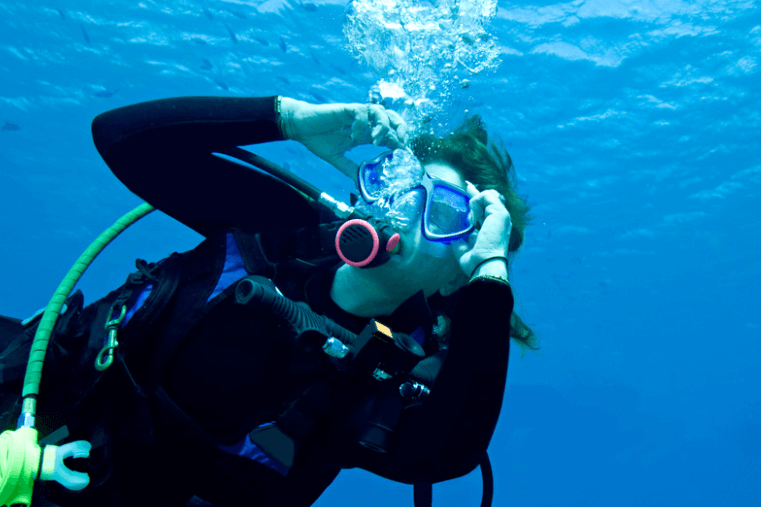Confined water debriefings
Create confidence and self esteem
Confined water debriefings
Confined water debriefings can create confidence and self esteem.
Clever instructors not only install confidence, but also use the power of words to reinforce what the students have just learned.
Most of all, instructors use the student’s sub-conscious mind to remedy problems.
Confined water skill debriefings on a PADI IDC
First we’ll look at the components of a PADI IDC/IE confined water debriefing.
Then we’ll look at how PADI Instructors generally follow this formula after their IE.
Finally we’ll take a closer look to see how the most influential and successful instructors energise their students to improve their skills.
PADI confined water teaching debriefing points
- Provided specific positive reinforcement related to skill technique.
- Stated a problem that actually occurred.
- Reinforced proper technique for a problem that occurred.
- Restated performance requirement.
- Reinforced a realistic value for skill.

The "old" traditional way of debriefing a skill
Let’s take a look at a typical confined water debriefing that you’ll hear on a PADI IDC, or PADI Instructor Exam.
We can also see how points are scored.
Here we go!
The instructor candidate surfaces, big smile on their face, and slates already in hand.
Students gather around.
The instructor starts:
Positive Reinforcement
“Wow”
“That was terrific! Well done everyone. I loved the way that you all blew bubbles when your regulator was out of your mouth!”
Tick! One point!
Problem / Reinforce proper technique
“I did notice a problem though. One of you couldn’t find their regulator.
Next time, I suggest that you lean over so that the regulator falls where you can see it.”
Another problem that I saw was that the regulator didn’t go far enough behind the shoulder.
Next time, I suggest that you make sure that it’s right behind you before you start to sweep your arm around.”
Tick! Tick! Two more points.
Restated performance requirement
“However, You’ve all met the performance requirement which was to….”
*reads slate*
“Recover a regulator from behind the shoulder.”
Tick! Another point!
Value
“And the value is in the unlikely event that if your regulator gets knocked out of your mouth by another diver, you can safely recover it.”
Tick! Full marks! A great FIVE!
After the IE. What happens in the real world?
I’m guessing that you regularly hear confined water debriefings just like this at your local pool?
No? Me neither.
Why is that? What’s wrong with it?
Why aren’t instructors using the formula from the PADI IDC/IE?
Well, if you ask an instructor, they’ll probably tell you that it feels “uncomfortable”.
Instinctively it “doesn’t feel right”.
What is the actual problem?
Actually the structure and the content of the debrief is more or less perfect.
It’s a similar debrief outline used in many industry training sessions around the world.
The reason that it doesn’t make sense is because of the lesson that it’s following.
In other words it’s more to do with the lesson than the debrief.
In a moment, we’ll see how the best instructors in the world use the whole process in a natural way that enhances learning and gives reinforcement to students.
But for now, we’ll look at why it doesn’t sit well with PADI professionals.
Why the IDC / IE format doesn't "feel" right.
If we go down the list, we can take things one by one.
Positive reinforcement
We know that Positive Coaching is a terrific tool in any PADI professional’s toolbag.
So what is wrong here?
The beauty of Positive Coaching is to give specific compliments to specific people at specific times.
Giving general praise for something that the students were expected to do in the first place is just seen at best as mild encouragement.
Mental noise
Usually, it goes in one ear and out the other.
It doesn’t do any good, it’s just the same “mental noise” as those instructors that say:
“great job”, “that was brilliant”, “that’s amazing”,
all the time without being specific.
Stated a problem that actually occured
Getting students to focus on what they did wrong is contrary to even the most basic human instincts.
Anyone who has taught anything knows this.
Every parent knows that emphasising bad behaviour, increases the chances of it recurring.
Stating the word “Problem” is a massive problem for empathetic instructors.
The IDC and IE
I think that the reason why PADI insists on IDC and IE candidates stating that a problem has occurred, is because some IE candidates simply imply a problem by saying something like:
“You need to remember to blow bubbles.”
or
“You need to lean over more.”
So in effect stating a solution while only implying a problem.
PADI quite rightly suggests this can cause confusion.
Negativity Bias
Another reason why instructors are instinctively hesitant to use the word “Problem” is because of Negativity Bias.
This is our tendency to register negative actions readily and then to dwell on them.
This negativity bias means that we feel the sting of a mistake more powerfully than we feel the joy of praise.
Yet another reason why Positive Coaching is so powerful.
Catch 22
So here we have a problem!
We shouldn’t use the word “problem” because of the negativity bias,
But we should state a “problem” to avoid confusion.
So which is it?
More later!
Reinforce proper technique
In some ways, this is the most misunderstood, and at the same time the most important part of the IDC/IE debriefing.
Allow people to learn
During the lesson, students should have been given the freedom to learn the skill using their own learning style.
Usually, students will have experimented, each finding the way that works best for them.
By the time that the instructor had offered a handshake, or given a similar sign of success, each individual student will already have worked out several minor solutions.
It’s the way that we all learn everything.
By the time the debrief comes along, the student will have already reached the performance requirement, worked out a few ideas and hopefully had a little more practice.
Pointing out that the student should have done something a different way, isn’t the best method of increasing confidence.
Particularly because they had already solved the issue themselves!
It just makes the instructor look a bit silly.
Performance Requirement and Value
In my article about confined water briefing, I talk about reading the performance requirement from the slate and giving a value.
As in the briefing, it’s much more powerful to involve the student in both.
Where do we go from here?
I mentioned above that the format and content of the debrief is excellent!
So why does it seem so unnatural?
Well, let’s assume that the students were allowed to learn.
Let’s assume that the instructor gave the students the time and space to work things out.
Let’s also assume that the instructor didn’t just move on when they saw a student perform the skill only one time.
Confined water debriefings
This time, let’s make it more personal!
We can make it far more Student Centred, if we talk directly to each student.
Make them feel special!
We can show them that we care about them, rather than just generally telling the whole class what problems we saw!
We can give better debriefings!
Peformance Requirement
We can ask one of the class to read out the performance requirement that they’ve just performed.
Take it in turns to read out from your slate.
It’s funny that often the “penny has dropped” a little more when the students see the performance requirement again after they’ve done the skill.
It somehow seems to have a little more clarity once they’ve mastered it, than it had before the lesson.
Getting one student in turn to read out the performance requirement helps to involve the student in their development.
I talk about it more in the article about Confined Water Briefings.
The value of the skill
A really powerful way to encourage the students to get involved is by asking them why they think that the skill is important.
There are a few psychological reasons why this is really helpful.
First off, it gets their mind working.
It’s impossible for them to give you a value, without re-living the skill.
This simple exercise enables them to reinforce the steps of the skill in their unconcious mind.
It makes the skill more natural.
Now they’ve completed the skill, you’ll be surprised that sometimes, they’ll give you a different value than they did during the briefing.
That’s because now that they have experienced it themselves, they might now see the skill in a different light.
Problems / Reinforce proper technique
Almost certainly, the students met with a few minor issues while learning the skill.
We also know that people learn from their experiences.
It’s also really important that we reinforce proper technique that solved those issues.
So instead of pointing out the problem directly.
We should still focus on the way that the students solved their problems.
Something like:
“And that’s not all that you learned was it?”
“You soon worked out that you had to lean right over to get hold of your regulator”
“What did you do when you couldn’t get that regulator the first time around?”
Make it interactive
It’s much more powerful if you ask the student to tell you how they solved a problem.
They have to search in their mind to tell you.
This brings back the emotions, thoughts and the technique that brought results.
Positive Coaching
If you praise them, right there, right then for the precise method that they used, to solve their problems, it will make a positive impression and give confidence.
Even if the instructor had to coach the student underwater, and suggest techniques to help, all of this still applies.
Regardless of the instructor’s guidance, it’s still the student who mastered the skill. It’s the student that worked out if it would be successful or not.
So either way, the student gets the praise.
Confidence boosting and self esteem
Conducting confined water debriefings in this manner creates a “feel good” factor that reinforces correct behaviour and increases relevance.
It builds self confidence and makes students feel good about themselves and their ability.

How can you be a better PADI Professional?
Sign up now for my online PADI IDC Preparation Course.
It’s full of new ideas about how to TEACH both theory and skills.
Lots more information here:
FULL IDC PREPARATION COURSE
